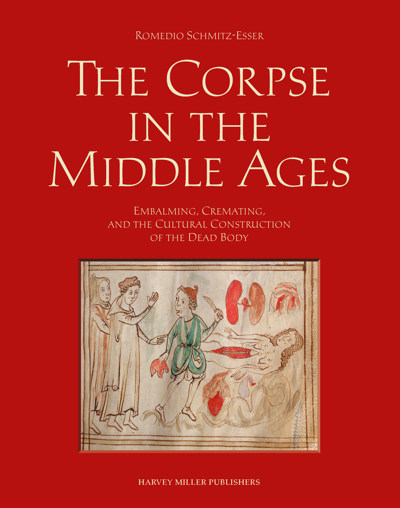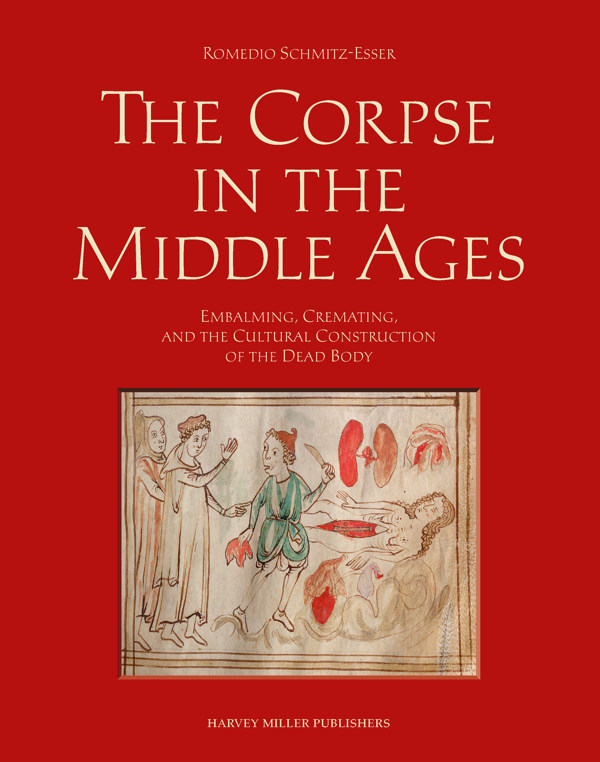
The Corpse in the Middle Ages
Embalming, Cremating, and the Cultural Construction of the Dead Body
Romedio Schmitz-Esser
- Pages: vi + 780 p.
- Size:220 x 280 mm
- Language(s):English, Latin
- Publication Year:2021
- € 150,00 EXCL. VAT RETAIL PRICE
- ISBN: 978-1-909400-87-0
- Hardback
- Available
"A study of the dead body in the context of cultural studies and the history of mentality, this expansive volume covers the cultural construction, burial, and destruction of the corpse in medieval European society." (L. C. Attreed, in Choice, 59/6, 2022)
“A good scholarly contribution, after all, raises additional questions and points the way to further research. The Corpse in the Middle Ages will undoubtedly prompt further exchange on, and discussion of, many related topics.” (Charlotte A. Stanford, in The Medieval Review, 14/05/2022)
Romedio Schmitz-Esser is Professor of Medieval History at the University of Heidelberg, Germany. He studied History and Art History at Innsbruck and worked at Munich’s LMU University. He has held research fellowships in London (German Historical Institute), Paris (École des hautes études en sciences sociales) and at Duke University, and was a Guest Lecturer in Guangzhou, China. In Venice, Italy, he was Director of the Centro Tedesco di Studi Veneziani and Visiting Researcher at Università Ca’ Foscari. Before arriving at the University of Heidelberg in 2020, he was Professor of Medieval History at the University of Graz in Austria. He is a medievalist with a focus on Cultural Studies and the History of Mentality. His research interests include the material culture of the Middle Ages, the knowledge transfer between Asia and Europe, and the history of the corpse.
To what extent are the dead truly dead? In medieval society, corpses were assigned special functions and meanings in several different ways. They were still present in the daily life of the family of the deceased, and could even play active roles in the life of the community. Taking the materiality of death as a point of departure, this book comprehensively examines the conservation, burial and destruction of the corpse in its specific historical context. A complex and ambivalent treatment of the dead body emerges, one which necessarily confronts established modern perspectives on death. New scientific methods have enabled archaeologists to understand the remains of the dead as valuable source material. This book contextualizes the resulting insights for the first time in an interdisciplinary framework, considering their place in the broader picture drawn by the written sources of this period, ranging from canon law and hagiography to medieval literature and historiography. It soon becomes obvious that the dead body is more than a physical object, since its existence only becomes relevant in the cultural setting it is perceived in. In analogy to the findings for the living body in gender studies, the corpse too, can best be understood as constructed. Ultimately, the dead body is shaped by society, i.e. the living. This book examines the mechanisms by which this cultural construction of the body took place in medieval Europe. The result is a fascinating story that leads deep into medieval theories and social practices, into the discourses of the time and the daily life experiences during this epoch.
About the Translation
Foreword
Introduction
Chapter I: The Buried Corpse
Chapter II: The Holy Corpse
Chapter III: Embalming and the Preservation of Corpses
Chapter IV: Authority and the Corpse
Chapter V: The Community of the Dead and the Corpse in the “Ordo”
Chapter VI: The Corpse and the Law
Chapter VII: The Living Corpse
Chapter VIII: The Destruction and Desecration of Corpses
Chapter IX: The Corpse as Medicine and Miracle Cure
Chapter X: Heart, Head, and Hand—The Body Parts of Corpses from and Anthropological and Anatomical Perspective
Epilogue
Bibliography
Indices
Index of Bible passages
Index of Names
Index of Places



